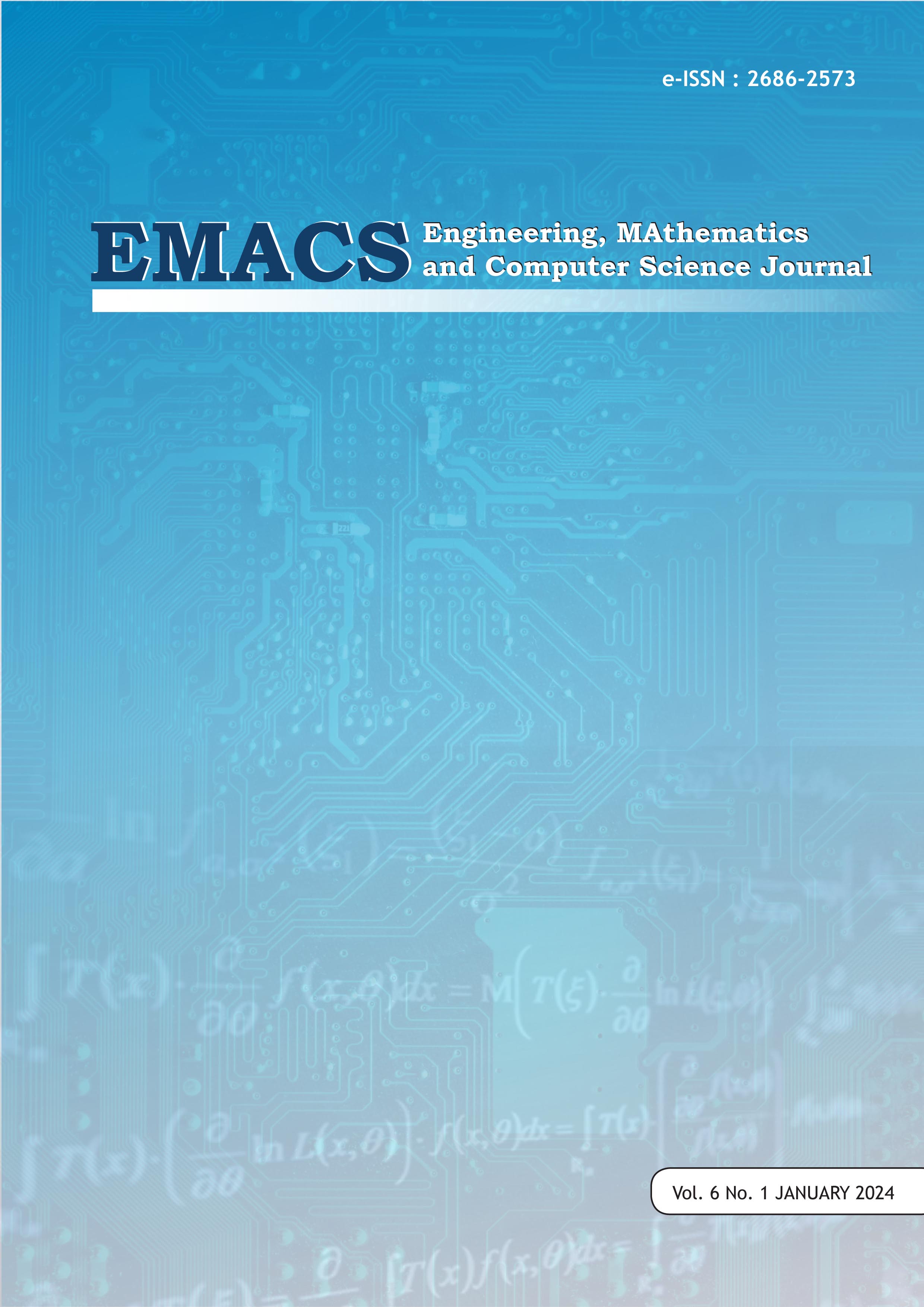Two-Layer Shallow Water Equations with Momentum Conservative Scheme for Wave Propagation Simulation
DOI:
https://doi.org/10.21512/emacsjournal.v6i1.10786Keywords:
Shallow Water Equations, Momentum Conservative, Water Wave Simulation, Staggered GridAbstract
In this paper, we discuss the implementation of momentum conservative scheme to shallow water equations (SWE). In shallow water model, the hydrodynamic pressure of the water is neglected. Here, the numerical calculation of mass and momentum conservation was applied on a staggered grid domain. The vertical interval was divided into two parts which made the computation quite efficient and accurate. Our focus is on the performance of the numerical scheme in simulating wave propagation and run-up phenomena, where the main challenge is to calculate the wave speed accurately and to count the non-linear term of the model. Here we also considered the wet and dry conditions of the topography. Three benchmark tests were picked out to validate the numerical scheme. A simulation of standing wave was carried out; the results were compared to the linear analytical solution and show a good fit. In addition, a simulation of harmonic wave propagation on a sloping beach was conducted, and the results closely align with the expected values from exact solution. Finally, we carried out a simulation of solitary wave with a sloping topography; and the results were compared to laboratory data. A good agreement was observed between the simulation results and experimental measurements.
References
Alfwzan, W., Yao, S. W., Allehiany, F. M., Ahmad, S., Saifullah, S., & Inc, M. (2023). Analysis of fractional non-linear tsunami shallow-water mathematical model with singular and non singular kernels. Results in Physics, 52. https://doi.org/10.1016/j.rinp.2023.106707
Cantero-Chinchilla, F. N., Bergillos, R. J., Gamero, P., Castro-Orgaz, O., Cea, L., & Hager, W. H. (2020). Vertically averaged and moment equations for dam-break wave modeling: Shallow water hypotheses. Water (Switzerland), 12(11). https://doi.org/10.3390/w12113232
Cao, Z., Huang, W., Pender, G., & Liu, X. (2014). Even more destructive: Cascade dam break floods. Journal of Flood Risk Management, 7(4). https://doi.org/10.1111/jfr3.12051
Carrier G. and Greenspan H. [1958] “Water waves of finite amplitude on a sloping beach,†Journal of Fluid Mechanics 4, 97–109.
Chang, T. J., Kao, H. M., Chang, K. H., & Hsu, M. H. (2011). Numerical simulation of shallow-water dam break flows in open channels using smoothed particle hydrodynamics. Journal of Hydrology, 408(1–2). https://doi.org/10.1016/j.jhydrol.2011.07.023
Cuomo, G., Allsop, W., Bruce, T., & Pearson, J. (2010). Breaking wave loads at vertical seawalls and breakwaters. Coastal Engineering, 57(4). https://doi.org/10.1016/j.coastaleng.2009.11.005
Dai, A., & Huang, Y. L. (2021). Boussinesq and non-Boussinesq gravity currents propagating on unbounded uniform slopes in the deceleration phase. Journal of Fluid Mechanics, 917. https://doi.org/10.1017/jfm.2021.300
Gamito, M. N., & Musgrave, F. K. (2002). An accurate model of wave refraction over shallow water. Computers and Graphics (Pergamon), 26(2). https://doi.org/10.1016/S0097-8493(01)00181-9
Kocaman, S., Güzel, H., Evangelista, S., Ozmen-Cagatay, H., & Viccione, G. (2020). Experimental and numerical analysis of a dam-break flow through different contraction geometries of the channel. Water (Switzerland), 12(4). https://doi.org/10.3390/W12041124
Liang, B., Wu, G., Liu, F., Fan, H., & Li, H. (2015). Numerical study of wave transmission over double submerged breakwaters using non-hydrostatic wave model. Oceanologia, 57(4). https://doi.org/10.1016/j.oceano.2015.07.002
Qian, H., Cao, Z., Liu, H., & Pender, G. (2018). New experimental dataset for partial dam-break floods over mobile beds. In Journal of Hydraulic Research (Vol. 56, Issue 1). https://doi.org/10.1080/00221686.2017.1289264
Smit, P., Zijlema, M., & Stelling, G. (2013). Depth-induced wave breaking in a non-hydrostatic, near-shore wave model. Coastal Engineering, 76. https://doi.org/10.1016/j.coastaleng.2013.01.008
Stelling, G., & Zijlema, M. (2003). An accurate and efficient finite-difference algorithm for non-hydrostatic free-surface flow with application to wave propagation. International Journal for Numerical Methods in Fluids, 43(1). https://doi.org/10.1002/fld.595
Synolakis, C. E. [1986] “The run-up of solitary waves, J. Fluid Mech. 185, 523–545.
Taylor, G. I. (1953). An experimental study of standing waves. Proceedings of the Royal Society of London. Series A. Mathematical and Physical Sciences, 218(1132), 44–59.
Tinh, N. X., Tanaka, H., Yu, X., & Liu, G. (2021). Numerical implementation of wave friction factor into the 1D tsunami shallow water equation model. Coastal Engineering Journal, 63(2). https://doi.org/10.1080/21664250.2021.1919391
Wang, Z. A., Yang, A., & Zhao, K. (2023). Wave propagation and stabilization in the Boussinesq–Burgers system. Physica D: Nonlinear Phenomena, 447. https://doi.org/10.1016/j.physd.2023.133687
Downloads
Published
How to Cite
Issue
Section
License
Copyright (c) 2024 Maria Artanta Ginting, Dani Suandi, Yasi Dani

This work is licensed under a Creative Commons Attribution-ShareAlike 4.0 International License.
Authors who publish with this journal agree to the following terms:
- Authors retain copyright and grant the journal right of first publication with the work simultaneously licensed under a Creative Commons Attribution License - Share Alike that allows others to share the work with an acknowledgment of the work's authorship and initial publication in this journal.
- Authors are able to enter into separate, additional contractual arrangements for the non-exclusive distribution of the journal's published version of the work (e.g., post it to an institutional repository or publish it in a book), with an acknowledgment of its initial publication in this journal.
- Authors are permitted and encouraged to post their work online (e.g., in institutional repositories or on their website) prior to and during the submission process, as it can lead to productive exchanges, as well as earlier and greater citation of published work.
USER RIGHTS
All articles published Open Access will be immediately and permanently free for everyone to read and download. We are continuously working with our author communities to select the best choice of license options, currently being defined for this journal as follows: Creative Commons Attribution-Share Alike (CC BY-SA)





